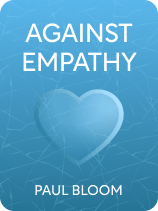

This article is an excerpt from the Shortform book guide to "Against Empathy" by Paul Bloom. Shortform has the world's best summaries and analyses of books you should be reading.
Like this article? Sign up for a free trial here.
How does empathy impact the way you view others in relation to yourself? What are the two different types of empathy?
According to psychologist Paul Bloom, empathy is “the act of coming to experience the world as you think someone else does.” He makes an important distinction between two kinds of empathy: emotional empathy and cognitive empathy.
Keep reading to learn about this perspective on empathy.
Paul Bloom Defines Empathy
According to Paul Bloom, empathy is the experience of understanding the world as someone else does. He borrows this definition from philosopher Adam Smith. Bloom explains that, when Smith was writing in the 18th century, what we call “empathy” today went by the name of “sympathy,” which Smith defined as our natural capacity to feel what others feel.
(Shortform note: Experts explain that, according to Adam Smith, “sympathy” (what Bloom calls “empathy”) arises from our ability to feel what we imagine others must feel. Some scholars interpret Smith’s “sympathy” differently than Bloom does. Historian Blake Smith writes that Adam Smith envisioned sympathy as something bigger than Bloom’s “empathy,” as a capacity inextricable from imagination and reason and a core part of our psychological life.)
Feeling empathy for other people requires us to blur the lines a little between ourselves and others. Bloom writes that, while there’s a difference in the brain’s representation of the self versus the other, there is also an overlap between them, and this overlap may confer evolutionary advantages. For instance, it may prompt us to protect our family members as we protect ourselves, ensuring the survival of our genetic material.
| Where Do We Draw the Line Between “Self” and “Other”? Not everyone experiences the overlap between ourselves and others in exactly the same way: The extent to which your concept of “self” overlaps with your concept of “other” is influenced by your culture. People who grow up in collectivist cultures place a greater emphasis on their membership in a group than on their individual identity. Your preference for individualism or collectivism affects how you think and how your brain functions. Neuroscientists observe different patterns of neural activity in people depending on how strongly they identify with individualistic versus collectivistic cultural values, which suggests a difference in the way their brains represent the concept of the “self.” There’s also evidence to suggest that these differences in behavior and brain activity are in turn influenced by genetics. Researchers have found that people in traditionally collectivist cultures have evolved a genetic profile that favors collectivistic behavior, as well as helping to protect them against mood disorders such as anxiety and depression. |
Bloom differentiates between two types of empathy that equip us with distinct ways of caring about other people: cognitive empathy and emotional empathy.
Emotional Empathy vs. Cognitive Empathy
In defining empathy and sketching out his case against it, Bloom characterizes “emotional empathy” and “cognitive empathy” as two distinct internal experiences. He writes that some neuroscientists believe that the brain actually uses two different systems for these processes, one that allows us to feel someone else’s feelings and another that allows us to understand someone else’s feelings.
The kind of empathy that Bloom argues against throughout the book is emotional empathy. Emotional empathy involves feeling someone else’s emotions and simulating their experiences. This ability is thought to draw on neural systems like mirror neurons: brain cells that activate both when we perform an action and when we observe someone else perform it. Some researchers think mirror neurons represent the neural starting point of empathy.
Cognitive empathy entails a more distanced appreciation of someone else’s experiences. Also called “mentalizing” or “theory of mind,” cognitive empathy involves understanding the emotions someone else is experiencing without experiencing them yourself. Bloom doesn’t oppose the use of cognitive empathy. In fact, he suggests that we need to understand others’ experiences to make morally good decisions, and cognitive empathy helps us do that.

———End of Preview———
Like what you just read? Read the rest of the world's best book summary and analysis of Paul Bloom's "Against Empathy" at Shortform.
Here's what you'll find in our full Against Empathy summary:
- How the conventional understanding of empathy gets it wrong
- How empathy can motivate us to act in unjust, irrational, and cruel ways
- Why we should practice rational compassion instead of empathy






